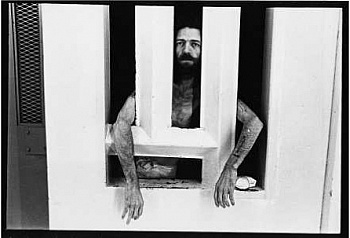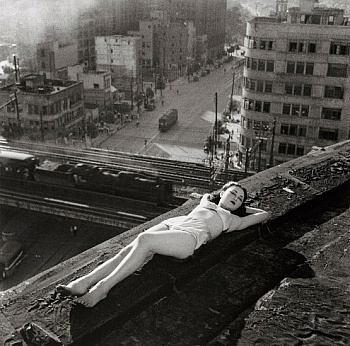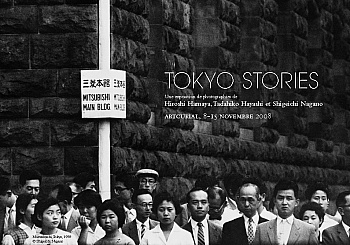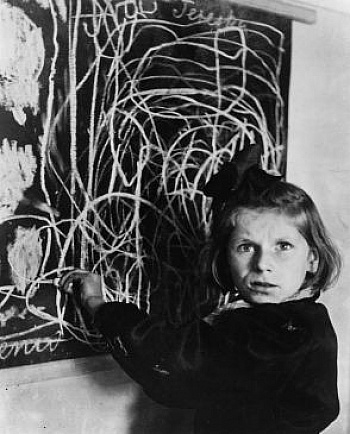Hiroshi Hamaya est un photographe japonais né le 28 mars 1915, Tokyo, Japon, extrêmement connu pour ses travaux sur la vie quotidienne tokyoïte et ses nombreux clichés de villages de la préfecture de Niigata. En 1956, il publia son premier livre, Snow Land, regroupant un nombre important de photographies de petits villages du Japon, tous sous la neige. Les filiations avec la photographie journalistique sont nombreuses, que ce soit dans la composition ou la lumière (on est loin de l’exagération d’un Hosoe par exemple). Bref, un magnifique panorama de l’époque, avec quelques superbes portraits. Dans les années 60-70, il se recentrera sur des photos de paysages, a Honshu, offrant ainsi un sublime voyage en terre nippone au spectateur. Attention, je vais mettre plein d’images. C’est tellement beau qu’il serait bête de se priver.
Exposition Exposition : « A Chronicle of Grief and Anger » de Hiroshi Hamaya Exposition Getty exhibition presents two sides of modern japanese photography Exposition Terre Humaine en Photographie, à la BNF Exposition Focus Japan Exposition Tokyo Stories opening at Kulturhuset, Stockholm Exposition Tokyo Stories - Hiroshi Hamaya, Tadahiko Hayashi & Shigeichi Nagano Exposition Japan: a Self-Portrait, Photographs 1945-1964 Exposition Tokyo Stories photographies de Hiroshi Hamaya, Tadahiko Hayashi et Shigeichi Nagano Exposition Magnum Photos 60 years at the Stedelijk Museum Modifier l'image
 L'exposition comprendra une série de 32 tirages vintage qui ont été réalisées pour la publication du livre Ikari to kanahsimi no kiroku (Kawade Shobo Shinsha,1960), une documentation des manifestations contre le renouvellement du traité de sécurité entre les Etats-Unis et le Japon en 1960. Ces tirages seront exposés en Europe pour la première fois. Hamaya a commencé sa carrière photographique dans les années 1930 avec une série d'images prises dans les rues de sa ville natale de Tokyo.
En 1960, le Traité de coopération mutuelle et de sécurité entre les Etats-Unis et le Japon (Sōgo Kyōryoku Oyobi Anzen Hoshō Jōyaku), connu sous le nom de « Anpo », devait être renouv...
L'exposition comprendra une série de 32 tirages vintage qui ont été réalisées pour la publication du livre Ikari to kanahsimi no kiroku (Kawade Shobo Shinsha,1960), une documentation des manifestations contre le renouvellement du traité de sécurité entre les Etats-Unis et le Japon en 1960. Ces tirages seront exposés en Europe pour la première fois. Hamaya a commencé sa carrière photographique dans les années 1930 avec une série d'images prises dans les rues de sa ville natale de Tokyo.
En 1960, le Traité de coopération mutuelle et de sécurité entre les Etats-Unis et le Japon (Sōgo Kyōryoku Oyobi Anzen Hoshō Jōyaku), connu sous le nom de « Anpo », devait être renouv... LOS ANGELES—The Taishō era (1912–1926) was a brief but dynamic period in Japan’s history that ushered in a modern state with increased industrialization, shifting political parties, radical fashions, and liberal thinking in many areas. However, this era of heightened experimentation ended with the arrival of an international depression, the promotion of ultranationalism, and the country’s entry into what would become the Greater East Asia War.
Reflecting both sides of this dramatic transition, two disparate representations of modern Japan will be displayed together in Japan’s Modern Divide: The Photographs of Hiroshi Hamaya and Kansuke Yamamoto, on view March 26–August 25, 2013, at the J. Paul Getty Museum, Getty Center. Curated by Judith Keller, senior curator of photog...
LOS ANGELES—The Taishō era (1912–1926) was a brief but dynamic period in Japan’s history that ushered in a modern state with increased industrialization, shifting political parties, radical fashions, and liberal thinking in many areas. However, this era of heightened experimentation ended with the arrival of an international depression, the promotion of ultranationalism, and the country’s entry into what would become the Greater East Asia War.
Reflecting both sides of this dramatic transition, two disparate representations of modern Japan will be displayed together in Japan’s Modern Divide: The Photographs of Hiroshi Hamaya and Kansuke Yamamoto, on view March 26–August 25, 2013, at the J. Paul Getty Museum, Getty Center. Curated by Judith Keller, senior curator of photog... La Bibliothèque nationale de France rend hommage à la prestigieuse collection Terre Humaine, fondée et dirigée depuis 1954 par Jean Malaurie, à l’occasion du don par les éditions Plon et par Jean Malaurie lui-même d’un ensemble de plus de deux mille clichés. Après avoir célébré le cinquantenaire de la collection par une grande exposition en 2005, la Bibliothèque présente dans sa Galerie des donateurs plus de cent cinquante images, qui montrent l’importance de la photographie dans cette œuvre éditoriale majeure.
La photographie tient une place essentielle dans la collection Terre Humaine. Souvent consubstantielle à l’œuvre, elle exprime l’amour, la force de convict...
La Bibliothèque nationale de France rend hommage à la prestigieuse collection Terre Humaine, fondée et dirigée depuis 1954 par Jean Malaurie, à l’occasion du don par les éditions Plon et par Jean Malaurie lui-même d’un ensemble de plus de deux mille clichés. Après avoir célébré le cinquantenaire de la collection par une grande exposition en 2005, la Bibliothèque présente dans sa Galerie des donateurs plus de cent cinquante images, qui montrent l’importance de la photographie dans cette œuvre éditoriale majeure.
La photographie tient une place essentielle dans la collection Terre Humaine. Souvent consubstantielle à l’œuvre, elle exprime l’amour, la force de convict... «Focus Japan» is the first of our exhibitions about Japanese Photography this year.
We start with an overview of our collection. Alongside watercoloured Albumines from the 19th century, at that time mainly produced for travellers from the West, we show samples from the sixities and seventies, two important decades for Japanese Photography, as well as some works of the younger generation. Among others are: Rinko Kawauchi, Ruji Miyamoto, Ikko Narahara, Koji Onaka, Toshio Shibata und Issei Suda.
Alongside original prints you will also find a large range of Japanese Photography books. Compared to the US and Europe there are still only few galleries and public institutions in Japan that organise photography exhibitions. Therefore photobooks carry special importance for the reception of photography in Japan.
...
«Focus Japan» is the first of our exhibitions about Japanese Photography this year.
We start with an overview of our collection. Alongside watercoloured Albumines from the 19th century, at that time mainly produced for travellers from the West, we show samples from the sixities and seventies, two important decades for Japanese Photography, as well as some works of the younger generation. Among others are: Rinko Kawauchi, Ruji Miyamoto, Ikko Narahara, Koji Onaka, Toshio Shibata und Issei Suda.
Alongside original prints you will also find a large range of Japanese Photography books. Compared to the US and Europe there are still only few galleries and public institutions in Japan that organise photography exhibitions. Therefore photobooks carry special importance for the reception of photography in Japan.
... Studio Equis presents Tokyo Stories, a group exhibition revealing the multiple faces of Tokyo from the 1930s to the present day. A limited edition portfolio of 9 Digigraphie prints by Epson will be available at Kulturhuset during the exhibition.
With over 100 rare prints, many of which have previously never been seen outside of Japan, Tokyo Stories shows the dramatic evolution of the Japanese capital through the work of three of Japan’s leading documentary photographers: Hiroshi Hamaya, Tadahiko Hayashi and Shigeichi Nagano.
The exhibition was first presented at Artcurial in Paris in November 2008 as part of the official programme of Paris Photo....
Studio Equis presents Tokyo Stories, a group exhibition revealing the multiple faces of Tokyo from the 1930s to the present day. A limited edition portfolio of 9 Digigraphie prints by Epson will be available at Kulturhuset during the exhibition.
With over 100 rare prints, many of which have previously never been seen outside of Japan, Tokyo Stories shows the dramatic evolution of the Japanese capital through the work of three of Japan’s leading documentary photographers: Hiroshi Hamaya, Tadahiko Hayashi and Shigeichi Nagano.
The exhibition was first presented at Artcurial in Paris in November 2008 as part of the official programme of Paris Photo.... Focusing on street life, its spontaneity and drama, three of Japan’s leading photographers document a city in change. With close to 100 rare prints, many of which have previously never been seen outside of Japan, Tokyo Stories reveals the changing faces of Tokyo from the 1930s until the present day.
Tokyo is a city of contrasts, a kaleidoscope of images, where the futuristic present thrives alongside the traditional past. The exhibition reveals the city through its people: student protests, political intrigues, the birth of ‘salary men’ and their endless workdays, geishas, prostitutes, street orphans, writers, artists, designers and fashionistas, all of these characters collide to create this city of layers and contrasts.
As a native of Tokyo, the city naturally became Hiroshi Hamaya&r...
Focusing on street life, its spontaneity and drama, three of Japan’s leading photographers document a city in change. With close to 100 rare prints, many of which have previously never been seen outside of Japan, Tokyo Stories reveals the changing faces of Tokyo from the 1930s until the present day.
Tokyo is a city of contrasts, a kaleidoscope of images, where the futuristic present thrives alongside the traditional past. The exhibition reveals the city through its people: student protests, political intrigues, the birth of ‘salary men’ and their endless workdays, geishas, prostitutes, street orphans, writers, artists, designers and fashionistas, all of these characters collide to create this city of layers and contrasts.
As a native of Tokyo, the city naturally became Hiroshi Hamaya&r... Concept
On August 15th, 1945 the Pacific War came to an end and with it fourteen years of bombings, of deprivation and of great sacrifice for the Japanese people. With the collapse of Japanese militaristic rule and the arrival of the US occupation forces, the nation suddenly found itself thrust into a new and uncertain era. The myth of the Emperor's divinity, which was born during the Meiji era, was replaced with the American attempt at their homegrown brand of democratisation.
The belief in the Emperor and his government, which had accompanied Japan's development for several decades, was shattered. At the same time, despite the surrounding physical destruction, a feeling of intense relief swept across the country accompanied by a thirst for freedom and creative expression. The Japanese people craved discovery: the...
Concept
On August 15th, 1945 the Pacific War came to an end and with it fourteen years of bombings, of deprivation and of great sacrifice for the Japanese people. With the collapse of Japanese militaristic rule and the arrival of the US occupation forces, the nation suddenly found itself thrust into a new and uncertain era. The myth of the Emperor's divinity, which was born during the Meiji era, was replaced with the American attempt at their homegrown brand of democratisation.
The belief in the Emperor and his government, which had accompanied Japan's development for several decades, was shattered. At the same time, despite the surrounding physical destruction, a feeling of intense relief swept across the country accompanied by a thirst for freedom and creative expression. The Japanese people craved discovery: the... Studio Equis présente, avec le soutien d’Epson, une exposition exceptionnelle, « Tokyo Stories », chez Artcurial du 8 au 15 novembre 2008. Près de 100 tirages rares, inédits pour la plupart hors du Japon, révèlent les personnalités multiples de Tokyo, des années 1930 à la fin du XXe siècle, à travers les oeuvres de trois photographes : Hiroshi Hamaya, Tadahiko Hayashi et Shigeichi Nagano.
Originaire de Tokyo, Hamaya (né en 1915) fait de sa ville son premier sujet photographique. Ses clichés des années 1930 révèlent une ville mystérieuse et exotique, radicalement différente de la mégalopole qu’on connait aujourd’hui. Hayashi (né en 1918), quand à lui, ...
Studio Equis présente, avec le soutien d’Epson, une exposition exceptionnelle, « Tokyo Stories », chez Artcurial du 8 au 15 novembre 2008. Près de 100 tirages rares, inédits pour la plupart hors du Japon, révèlent les personnalités multiples de Tokyo, des années 1930 à la fin du XXe siècle, à travers les oeuvres de trois photographes : Hiroshi Hamaya, Tadahiko Hayashi et Shigeichi Nagano.
Originaire de Tokyo, Hamaya (né en 1915) fait de sa ville son premier sujet photographique. Ses clichés des années 1930 révèlent une ville mystérieuse et exotique, radicalement différente de la mégalopole qu’on connait aujourd’hui. Hayashi (né en 1918), quand à lui, ... Throughout that period MAGNUM never ceased to supply photographs that have become part of the world’s collective memory – pictures of landmark events like the Russian army’s invasion of Prague in 1968 and the Tiananmen Square demonstrations in Beijing in 1989. The exhibition uses photographs, books and texts to illustrate the history of MAGNUM year by year and gives visitors the opportunity to view work by 83 photographers, such as Robert Capa, Henri Cartier-Bresson, Carl de Keyzer, Martin Parr, Susan Meiselas and Leonard Freed.
MAGNUM was established in 1947 by Robert Capa, Henri Cartier-Bresson, George Rodger and David Seymour. They were convinced that photography was the best medium with which to document world events and raise public awareness. And they succeeded – the way MAGNUM photographer...
Throughout that period MAGNUM never ceased to supply photographs that have become part of the world’s collective memory – pictures of landmark events like the Russian army’s invasion of Prague in 1968 and the Tiananmen Square demonstrations in Beijing in 1989. The exhibition uses photographs, books and texts to illustrate the history of MAGNUM year by year and gives visitors the opportunity to view work by 83 photographers, such as Robert Capa, Henri Cartier-Bresson, Carl de Keyzer, Martin Parr, Susan Meiselas and Leonard Freed.
MAGNUM was established in 1947 by Robert Capa, Henri Cartier-Bresson, George Rodger and David Seymour. They were convinced that photography was the best medium with which to document world events and raise public awareness. And they succeeded – the way MAGNUM photographer...